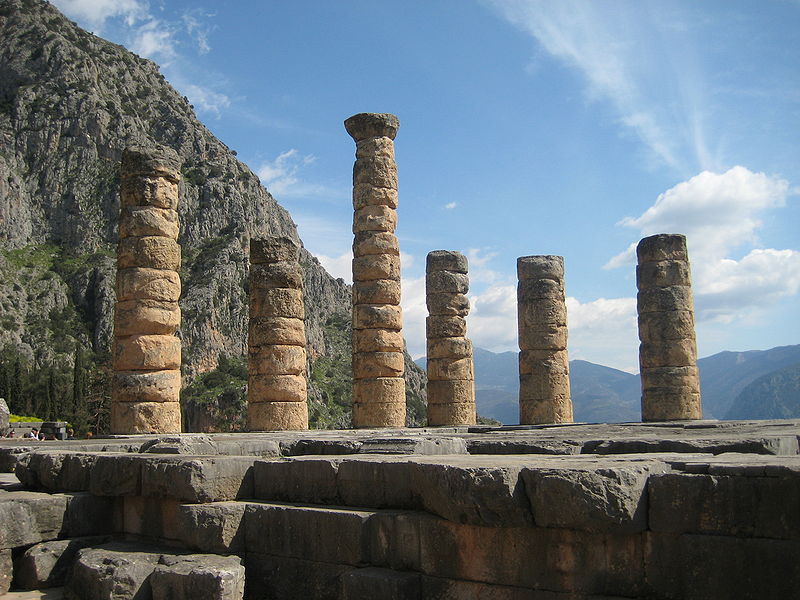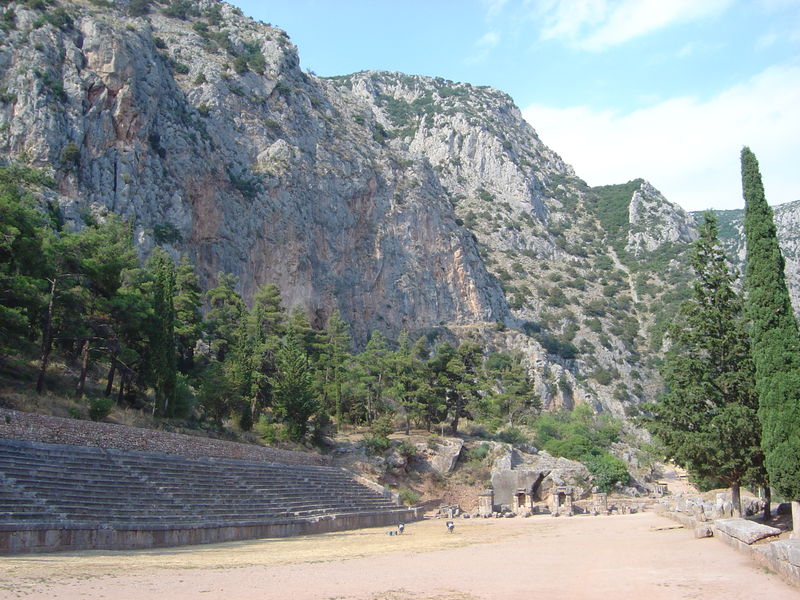Delphi
Delphi was the most important religious site of Ancient Greece. The site of Delphi, which lies on a plateau along the slope of Mount Parnassos in central Greece, was since the dawn of mythology associated with prophecy. It was also thought to be the center of the world ever since Zeus released two golden eagles to fly across the world and pinpoint the center which was called "the navel of the world". The eagles crossed eachother above Delphi and therefore Omphalos stone was used to denote this point. Delphi also had its reputation for being a sacred place all over Greece and was an independent city-state which usually didn't take sides with other city-states. But it still had great influence on other states because many essential decisions, both political and economical, were taken after a consultation with the Oracle. Also new colonies were not allowed to be founded without an agreement of the sanctuary at Delphi. The growing influence across the rising Greece enabled the settlement at Delphi to grow from a small village to impressive architectural compound of fine art.
The most sacred place on earth
According to Greek Mythology, it was thought since the dawn of time to be a sacred place of primeval goddess Gaea and later her daughter Themis who was a messenger of the voice of her mother. In this role of divine voice (themistes), she first instructed the primal laws of justice and morality to mankind. Themis, however, gave her place to her sister Phoebe who became the third prophet of the Oracle, but she was not there for long as she had felt like having extreme burden to carry. Therefore, according to Aeschylus, she gave her place to her grandson Apollo for his birthday. But according to Homer and several other sources, it is said that Apollo came to Mt. Parnassos to kill Python and because of killing the draconian monster, he also saved the nearby countryside. Therefore the people have built him a temple on a sacred shrine. Apollo then dedicated a bronze tripod to the sanctuary and appointed one of his priestesses to be a messenger by giving her divine powers of foresight. She was known as Pythia and she inhaled the hallucinating vapors from a chasm in a rock below the temple floor while she sat on a tripod. In this state she was able to connect with the divine. Then she spoke gibberish which priests interpreted as the enigmatic prophecies.
It is believed by some modern investigators that it was ethylene gas which was responsible for Pythia's state of inspiration, while others would argue that it was a methane gas emitted from the chasm. There is of course a third party of scholars who believe that Pythia spoke intelligibly with her own voice like the ancient sources claim.
Monuments of ancient Delphi
Beside the Temple of Apollo and Omphalos stone, there were other monuments built which were fortunately enough preserved to this day. There is also an ancient stadium which held seven thousand spectators every four year when the Greeks celebrated Apollo for slaying Python and honored him with Pythian games, one of the predecessors of Olympic games. Just above the temple of Apollo a theatre of white marble was built further up the hill which allowed five thousand spectators to enjoy plays, readings and various festivals. On top of that, they also had a spectacular sight on the sanctuary and the valley below. A mile east, from the sanctuary of Apollo, lies a Temple of Athena which the locals had built to honor goddess Athena. There is also the Athenian treasury which Athenians had built in order to make donations to the Oracle of Delphi.
Temple of Apollo

Most significant structure on site
Ancient Stadium

Incredible stadium just beneath the mountain
Theatre of Delphi

Delphic theatre with amazing spectacle